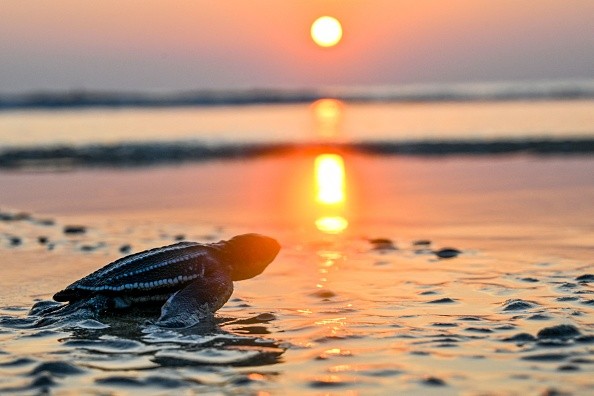As part of new steps to restore the health of the sea, three areas of water off the English coast will receive the tightest environmental protections.
At two other locations, plans to establish Heavily Protected Marine Areas (HPMAs) have been shelved.
Rewilding seas
 (Photo : CHAIDEER MAHYUDDIN/AFP via Getty Images)
(Photo : CHAIDEER MAHYUDDIN/AFP via Getty Images)

Prof. Callum Roberts of the University of Exeter noted that although the protected zones only covered 0.5% of the English seas, they would have a significant impact on the marine biodiversity there, as per the BBC.
The Wildlife Trusts announced that they will be urging the government to quickly declare additional, totally protected marine areas.
Head of marine conservation Dr. Lissa Batey said, "I'm completely appalled that the government has only chosen to designate three of the five planned HPMAs."
"They're a good first step but we really need to do more if we're to turn the tide on nature's recovery and bring wildlife back."
Richard Hill, of the Marine Conservation Society, echoed her words: "It's a step forward, but a baby step," he said. "It's a shame the government isn't being a bit more ambitious in protecting our seas."
The following places need to be completely protected:
A diversity of marine life can be found in the nearshore waters of Allonby Bay in Cumbria, including sponges, soft coral, seaweed, sea squirts, anemones, and living reefs created by honeycomb worms.
Dolphin Head is an area of water distant from the coast of Sussex where dolphins, porpoises, seabirds, and fish can be found.
The North East of Farnes Deep, 35 miles (55km) off the coast of Northumberland: the seabed is rich in weird and unique life-forms including long-lived molluscs and squat lobsters.
Seabirds and marine mammals, such as the white-beaked dolphin, abound in the waters.
Because concerns that a fishing restriction may completely destroy the local economy were raised, proposals at Holy Island in Northumberland were abandoned.
Trevelyan Inner Silver Pit South, located 26 kilometers (16 miles) off the coast of Lincolnshire, had a similar concept that was abandoned.
Cod, plaice, herring, and sole can all be caught there.
As part of a goal to safeguard 30% of marine waterways by 2030, the new scheme offers three areas off England full protection against harm from fishing, mining, and construction.
By 2026, Scottish officials intend to have at least 10% of their waters designated as HPMAs.
Due to decades of overfishing, pollution, and climate change, the seas are under stress.
Despite the fact that 38% of the oceans surrounding the British Isles are classified as marine reserves, many of them are still the subject of harmful fishing techniques like bottom-trawling, in which fishing gear is dragged down the seabed.
Also Read: Underwater Pollination: Scientists Discovered How Marine Animals Play a Part in Algae Fertilization
Why We Need Water For The Environment
Water from healthy rivers is used by houses, farms, businesses, and schools.
They support entire ecosystems along the road and offer vital habitats for local flora and animals.
NSW is reliant on its rivers, creeks, and wetlands to survive. They provide a place to unwind, unwind, and reconnect with nature while improving the quality of life in towns.
Healthy rivers are crucial to the spiritual, cultural, and physical well-being of Aboriginal people.
A healthy and productive river system has advantages that go far beyond the river bank.
Some of these advantages are obvious, while others are not.
But, each and every one of them-plants, animals, and people-is vital to the future of our river communities.
Recreational fishing, tourism, agriculture, industry, and public health all benefit from vigorous and productive river systems.
Water for the environment helps the river stay healthy so that it can meet human needs.
Water spreading across the floodplain releases carbon, igniting the food chain.
River pulses cause fish to reproduce and travel.
In floodplain wetlands, young fish can feed and grow safely before returning to the river to continue their life cycle.
Related article: Extraordinary Marine Animals Trap Microplastics and Carbon Dioxide, Slowing Climate Change
© 2024 NatureWorldNews.com All rights reserved. Do not reproduce without permission.


![Climate Change is Reducing Dust Levels Worldwide as Arctic Temperature Warms [Study]](https://1471793142.rsc.cdn77.org/data/thumbs/full/70320/280/157/50/40/climate-change-is-reducing-dust-levels-worldwide-as-arctic-temperature-warms-study.jpg)

![Tsunami Hazard Zones: New US Map Shows Places at Risk of Flooding and Tsunamis Amid Rising Sea Levels [NOAA]](https://1471793142.rsc.cdn77.org/data/thumbs/full/70325/280/157/50/40/tsunami-hazard-zones-new-us-map-shows-places-at-risk-of-flooding-and-tsunamis-amid-rising-sea-levels-noaa.jpg)
